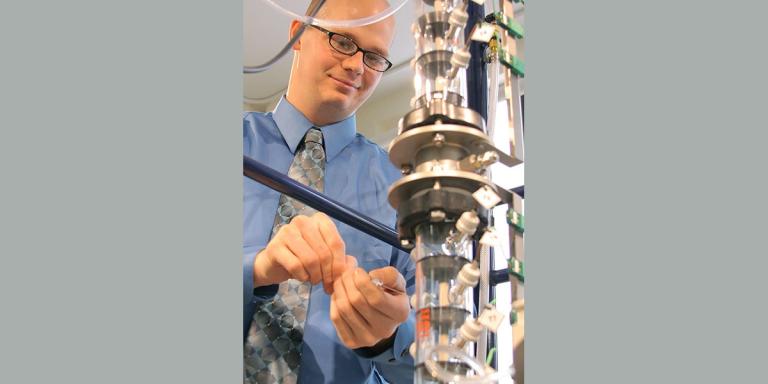
“It sounds simple, but the way the reactions occur, it took a year to quantify the gas and to do diagnostics on the reactor itself.”
From food and animal waste and sewage to chicken excrement, you never know what you will find in the laboratory refrigerators in the Applied Biology and Chemical Engineering labs where a team of Kettering University researchers are trying to make the process of creating energy from waste more efficient with the addition of glycerol, a byproduct of soybean crop processing.
“The soybean idea arose because we thought we could use parts of the plant that were not used and put it in a digester,” said Dr. Steve Nartker, assistant professor of Chemical Engineering. “There was a change but not a dramatic enough change to have a dramatic impact. So we had to look down the processing chain a bit.”
Nartker and Dr. Michelle Ammerman, assistant professor of Applied Biology, shifted their focus to glycerol. Biodiesel is a renewable fuel that can be used in vehicles. Narkter and Ammerman found that by using glycerol in a digester, they could increase the amount of biogas produced which could then potentially return renewable energy to the grid.
Dr. Steve Nartker and Dr. Michelle Ammerman
“It produced more than two-and-a-half times more biogas [with glycerol],” Ammerman said. “If you start adding glycerol slowly, you can get to these high levels.”
Nartker and Ammerman discovered that the addition of glycerol can increase the production of biogas, but how is biogas used? Local communities, including Flint, have Municipal Wastewater Treatment Plants in which they accumulate sewage, waste and anything else that is flushed or travels down the drain in households. The resulting sludge is a low value material that can be digested using anaerobic bacteria to create biogas. Once the biogas is created, it’s possible to convert it to 100 percent methane to be used as energy for households, however, that process is cost prohibitive. An alternative is to run the biogas through an engine attached to a generator which can result in the production of electricity. The process essentially converts waste to renewable and usable electricity at the municipal level.
Based on this process, the Michigan Soybean Promotion Committee funded Kettering’s research to see if the addition of glycerol as a substrate for the bacteria in the digester would increase the quantity of biogas produced.
“It sounds simple, but the way the reactions occur, it took a year to quantify the gas and to do diagnostics on the reactor itself,” Nartker said. “More gas was produced [with glycerol] than expected.”
If these findings were implemented by local municipalities, the results would be twofold. Firstly, it would result in more renewable energy production by communities and the associated lower energy costs; and secondly, it would create a market for glycerol produced by soybean farmers. However, according to Ammerman, with the ever-fluctuating energy and crop prices, the potential profitability of using glycerol is dependent on many variables outside of the farmers’ control which makes it difficult to assess sustainability of this process on a larger scale over a longer period of time.
“It’s even weather-dependent,” Nartker said. “Last year was not a good growing year, so soybean production yields were way down.”
Nartker presented the research’s findings at the American Institute of Chemical Engineers conference in September 2014 in Atlanta and again at the Michigan Academy of Arts and Letters conference in 2014 at Oakland University. The project at Kettering also provided research experience to Applied Biology and Chemical Engineering students. Denis Volobuev, an Applied Biology student who worked on the project, measured the “organic loading rates” by tracking the amount of methane produced by the bacteria. Volobuev enjoyed the project because he was able to assist with the design and hands-on implementation of the experiment.
“At first I hated research, but research is exciting ,” Volobuev said. “You are constantly putting a puzzle together. It’s a constant rush of adrenaline. You learn that it’s okay to try and fail and then go back and try again. I think that’s a very important lesson for life.”